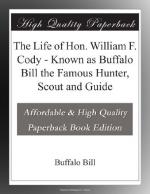Next morning we were again on the trail, which led north, and back towards the Beaver Creek, which stream it crossed within a few miles of the spot where we had first discovered the Indians, they having made nearly a complete circle, in hopes of misleading us. Late in the afternoon, we again saw them going over a hill far ahead of us, and towards evening the main body of warriors came back and fought us once more; but we continued to drive them until darkness set in, when we camped for the night.
Tie Indians soon scattered in every direction, but we followed the main trail to the Republican river, where we made a cut-off, and then went north towards the Platte river. We found, however, that the Indians by traveling night and day had got a long start, and the General concluded that it was useless to follow them any further, as we had pushed them so hard, and given them such a scare that they would leave the Republican country and go north across the Union Pacific railroad. Most of the Indians, as he had predicted, did cross the Platte river, near Ogallala, on the Union Pacific, and thence continued northward.
That night we returned to the Republican river and camped in a grove of cottonwoods, which I named Carr’s Grove, in honor of the commanding officer.
The General told me that the next day’s march would be towards the head-waters of the Beaver, and he asked me the distance. I replied that it was about twenty-five miles, and he said we would make it the next day. Getting an early start in the morning, we struck out across the prairie, my position as guide being ahead of the advance guard. About two o’clock General Carr overtook me, and asked how far I supposed it was to water. I thought it was about eight miles, although we could see no sign or indication of any stream in our front.
“Pepoon’s scouts say that you are going in the wrong direction,” said the General, “and in the way you are bearing it will be fifteen miles before you can strike any of the branches of the Beaver; and that when you do, you will find no water, for the Beavers are dry at this time of the year at that point.”
“General, I think the scouts are mistaken,” said I, “for the Beaver has more water near its head than it has below; and at the place where we will strike the stream we will find immense beaver dams, large enough and strong enough to cross the whole command, if you wish.”
“Well, Cody, go ahead,” said he, “I’ll leave it to you, but remember that I don’t want a dry camp.”
“No danger of that,” said I, and then I rode on, leaving him to return to the command. As I had predicted, we found water seven or eight miles further on, where we came upon a beautiful little stream—a tributary of the Beaver—hidden in the hills. We had no difficulty in selecting a good halting place, and obtaining fresh spring water and excellent grass. The General, upon learning from me that the stream—which was only eight or nine miles long—had no name, took out his map and located it, and named it Cody’s Creek, which name it still bears.




